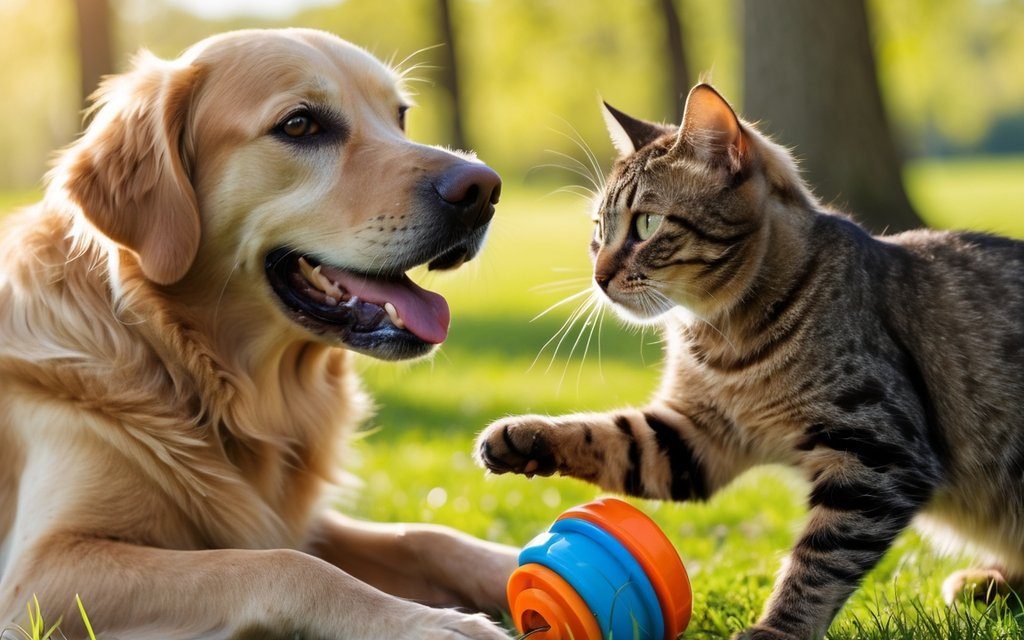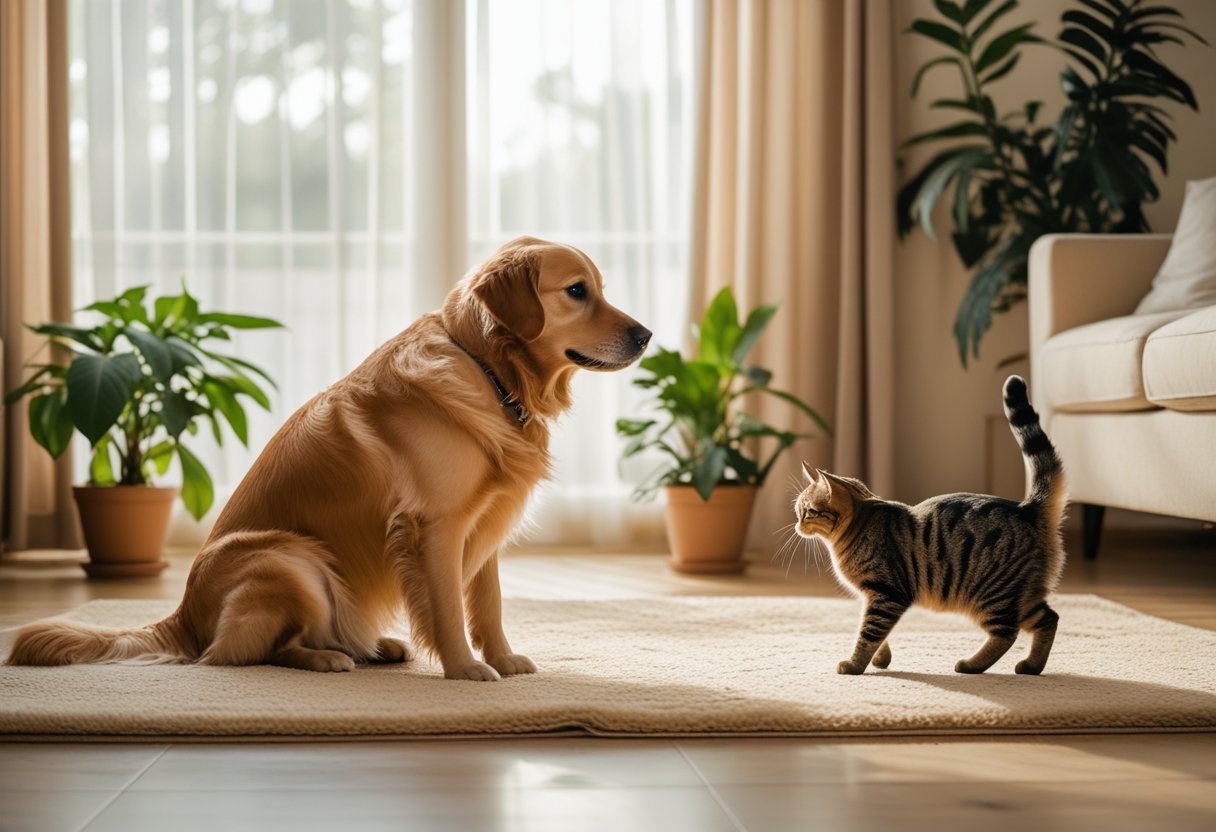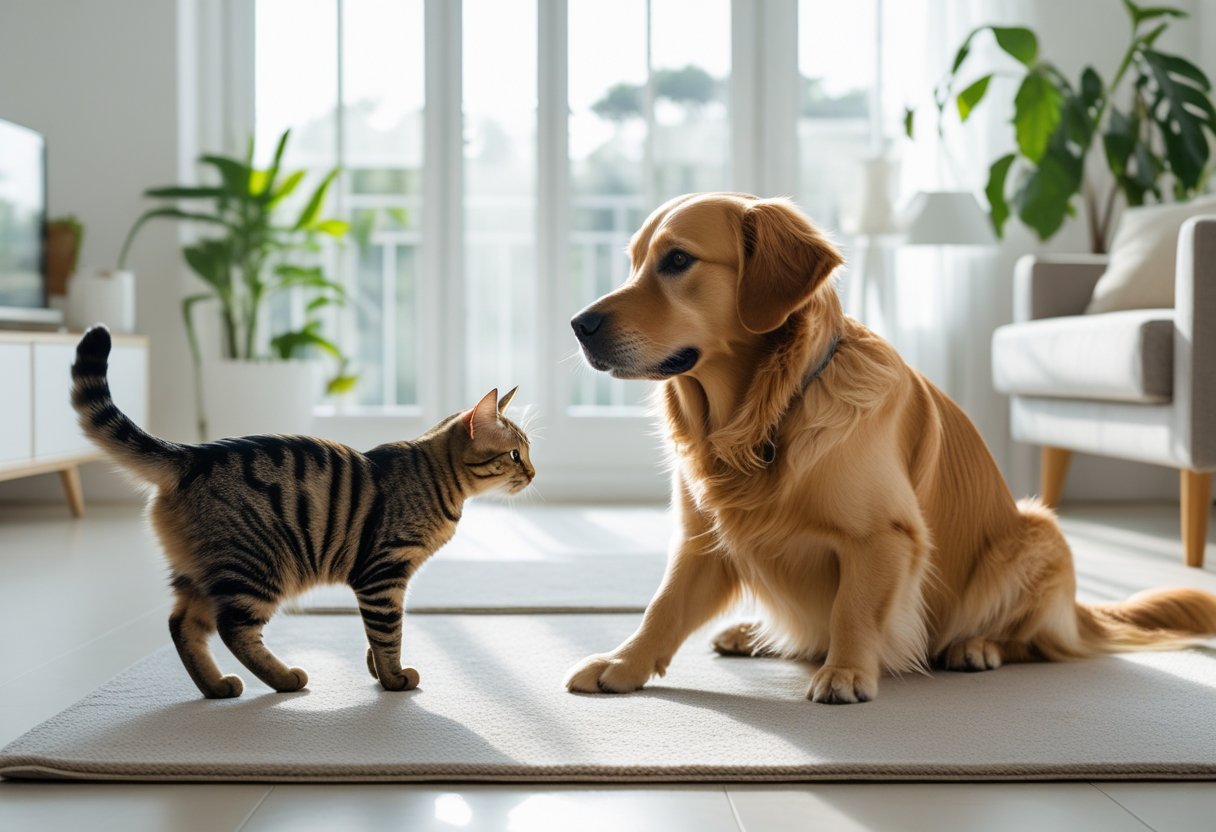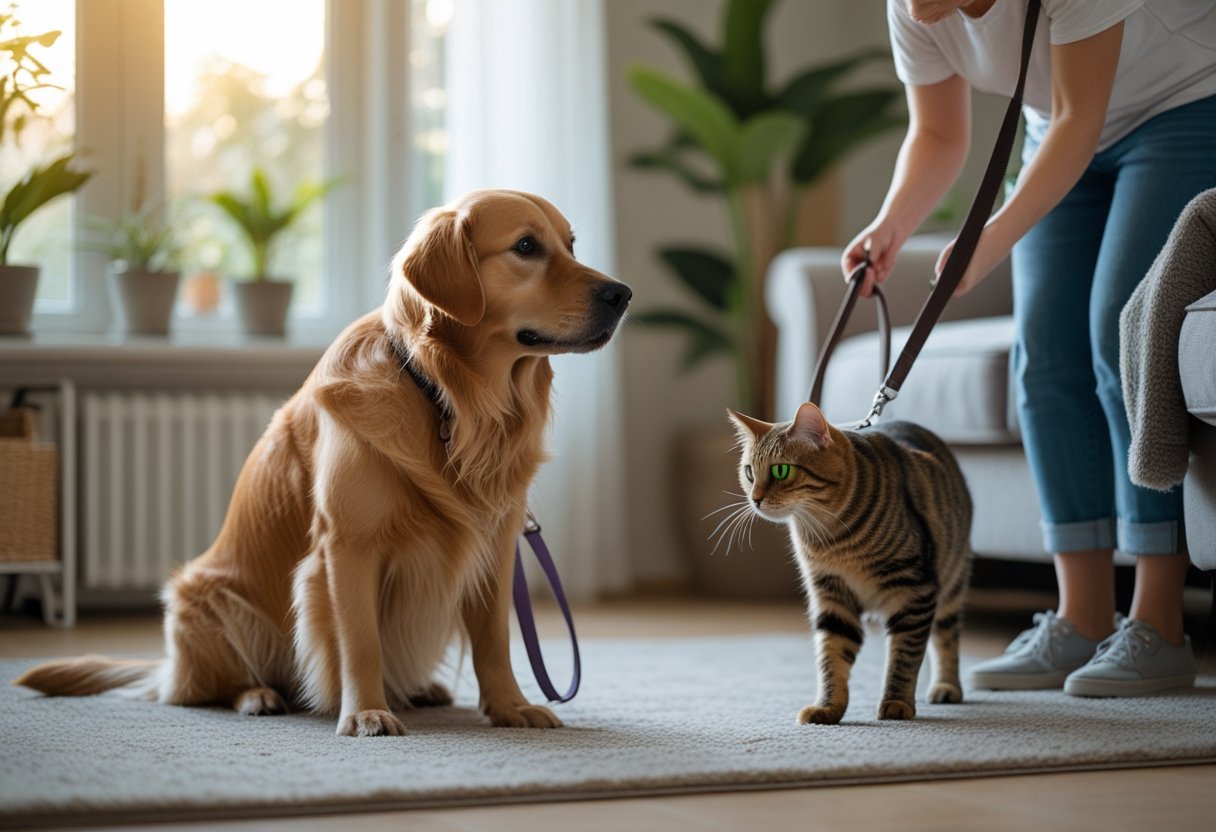Introducing a dog to a cat can feel tricky. With some patience and the right approach, your pets can learn to live together peacefully.
The key is to take things slowly and create a safe, calm environment where both animals feel secure. Let them get used to each other’s presence without pressure.
Start by setting up separate spaces. Use familiar bedding and toys so your dog and cat can explore scents and sounds before meeting face to face.
Understanding their different behaviours helps you manage their reactions. Take it step by step and build positive experiences so both pets feel relaxed as they adjust.
Pay attention to how your dog and cat respond. Praise calm behaviour and don’t force interaction.
Key Takeways
- Introduce your pets gradually in a quiet, safe space.
- Use scent and positive experiences to reduce stress.
- Watch for signs of comfort and never rush their meetings.
Understanding Dog and Cat Behaviour
When you introduce your dog to a cat, understanding their natural ways of expressing themselves helps a lot. Dogs and cats use their bodies and sounds differently to communicate.
Knowing what to look for can make the introduction smoother. It keeps everyone calm.
Decoding Dog Body Language
Dogs show how they feel mostly through posture, tail, and facial expressions. A relaxed dog has a loose body, wagging tail, and soft eyes.
If your dog’s tail is stiff or raised high, they might be alert or excited. A tail tucked between the legs usually means fear.
Watch for signs like:
- Ears forward or perked up: The dog is curious or focused.
- Staring or intense eye contact: Could mean interest or challenge.
- Lunging or stiff stance: Possible warning or excitement, which might scare the cat.
When your dog calms down, maybe by lying down or yawning, they’re more relaxed. Go ahead and praise them for being calm around the cat.
Spotting Cat Warning Signs
Cats have subtle but clear signals that show how they feel. Ears flattened against the head mean fear or annoyance.
Raised fur along the back or tail shows the cat feels threatened. Here are more signs to watch for:
- Hissing or growling: A direct warning to stay away.
- Swatting with claws out: The cat is ready to defend itself.
- Dilated pupils and crouching: The cat is anxious or preparing to run.
Give your cat a safe space to retreat if they feel overwhelmed. Being able to escape helps them stay calm during introductions.
Differences in Communication Styles
Dogs and cats really do express themselves differently, and this can cause misunderstandings. Dogs are more straightforward and approach to play or interact, often wagging their tails to show friendliness.
Cats, on the other hand, are cautious and private. They prefer slow, careful movements and use body language to set boundaries.
For example:
| Behaviour | Dog Meaning | Cat Meaning |
|---|---|---|
| Tail wagging | Friendly, happy | Agitated or excited (tail flick) |
| Direct eye contact | Interest or challenge | Threatening or fearful |
| Approaching quickly | Wants to play or greet | Can be seen as a threat |
Knowing these differences helps you guide your dog to respect the cat’s space. You’ll be able to spot when your cat needs more time to adjust.
If you want more tips on how their behaviours differ, check out this detailed guide on introducing dogs and cats.
Preparing Both Pets for Their Introduction
Getting your dog and cat ready to meet starts with making sure both feel safe and calm. Use their natural behaviours, like scent, to help them get used to each other slowly.
Having the right supplies on hand makes things easier for everyone. A little prep goes a long way.
Creating Safe Spaces and Sanctuaries
Before your dog and cat meet, set up a personal space for each. These should be places where they can eat, sleep, and relax without worrying about the other pet.
Cats love high shelves or quiet rooms to escape to. Dogs usually prefer a bed or crate where they feel secure.
Use baby gates or closed doors to keep them apart at first. This lets them see and smell each other safely, without any chasing or stress.
Make sure your cat always has easy escape routes. Feeling trapped can make things worse, so keep options open.
Scent Swapping Techniques
Scent is a powerful way for dogs and cats to learn about new friends. Start by swapping blankets or toys that smell like each pet.
Put these items in each other’s safe areas. Let them explore at their own pace.
Try gently rubbing a soft cloth on your new pet’s head and then dabbing it around your home. This spreads the new scent on familiar items, making the environment feel less strange.
Keep swapping bedding weekly until neither pet shows signs of stress. If you see avoidance or aggression, slow down.
Stocking Up on Calming Aids and Supplies
Having calming aids ready can ease tension during introductions. Products like pheromone diffusers or sprays help both pets relax.
These mimic natural calming scents that pets produce themselves. Also, keep treats and toys handy.
Use treats to reward calm behaviour during meetings. Chew toys or puzzle feeders keep your dog busy and help reduce excitement around your cat.
Stock up on barriers like baby gates, leads, and harnesses. Keeping control during first meetings is key.
With the right tools, your multi-pet household will feel safer and happier. If you want more advice, check Dogs Trust’s guide on dog and cat introductions.
Assessing Personalities and Readiness
Before you bring your dog and cat together, get a sense of how each pet might react. Their behaviours, past experiences, and natural drives will shape how smoothly they meet.
Watching closely and understanding these factors helps you prepare the safest introduction possible.
Evaluating Your Cat’s Temperament
Cats all have their own ways of dealing with new situations. Some are curious and confident, while others are shy or anxious.
Notice how your cat reacts to strangers or sudden noises. Do they explore new spaces, or do they hide?
If your cat hisses, puffs up, or swipes, they’ll need more time before meeting your dog. Give your cat safe spots to retreat to, like a high shelf or a separate room.
Think about how your cat acts around other animals, if they’ve met any before. This helps you decide if you need a slow or quicker introduction.
Understanding Your Dog’s Drive
Your dog’s energy and instincts matter a lot for introductions. Some dogs have a strong prey drive and might want to chase cats.
Others are more relaxed or social. Watch how your dog reacts when seeing cats outside or on walks.
If your dog gets very excited or focused on chasing, they need extra training before meeting your cat. Teaching commands like “leave it” or “stay” helps control those impulses.
Notice how your dog behaves around unfamiliar animals. Are they fearful, aggressive, or friendly? Stay patient and reward calm, gentle behaviour near your cat.
Considering Past Experiences with Other Animals
Both your dog and cat bring their history with other animals into this introduction. If your dog has lived with cats before and had positive experiences, that’s a good sign.
If they’ve shown aggression or fear, you’ll need to take things slowly. The same goes for your cat.
Did your cat live with dogs before? Were they stressed or calm? Knowing these details helps you adjust your plan.
If either pet has had bad experiences, watch for signs of stress like growling, hissing, or avoidance. It’s okay to pause and give your pets more time before trying again.
For more tips on careful introductions, see the guide on how to introduce your dog to your cat.
Step-by-Step Introduction Process
Introducing a dog to a cat takes patience and care. You want both pets to feel safe and curious, not scared or stressed.
Taking things slowly helps you build trust. It makes your home a more peaceful place for everyone.
Initial Visual Introductions
Start by letting your dog and cat see each other from a distance, without direct contact. Use a barrier like a baby gate or keep your dog on a leash so your cat can choose where to go.
This way, your cat feels in control and can observe without feeling trapped. Swap bedding or toys between them before this meeting to help both pets get used to each other’s scent.
Offer treats on either side of the barrier to create a positive link between smells and good things. Keep these sessions short—just a few minutes at first.
Watch their body language closely. If your cat hisses or your dog fixates too much, give them more time apart before trying again.
The goal is to make sure neither feels forced into the situation.
Supervised Face-to-Face Meetings
Once both pets seem calm with a barrier, you can try a closer meeting. Keep your dog on a leash and let your cat move around as they like.
Give your cat escape routes or high spots to jump to if they feel nervous. That way, they can take a break whenever they need it.
Let your dog sniff your cat gently during the meeting. After each sniff, use a simple command like “leave it” to redirect your dog and hand out a treat.
This helps your dog connect calmness with rewards. It also teaches them to listen when the cat is nearby.
Keep these first meetings short and as positive as possible. If your cat puffs up, growls, or your dog lunges, separate them calmly and try again later.
Your main job is to keep things safe and controlled. Don’t expect instant friendship—it’s about steady progress.
Gradually Increasing Interactions
When your pets can be close without stress, let them spend more time together in safe spaces. Always supervise at first.
Keep using the “leave it” command and have treats handy for calm behaviour. Let your cat explore your dog’s space and vice versa, but move at their pace.
Try playing with both pets nearby to create good memories. Watch for signs of jealousy or tension and give each pet equal attention.
For more details on the introduction process, see this step-by-step guide on introducing a dog to a cat.
Building Positive Associations and Training
Helping your pets feel calm around each other takes patience and some clear steps. Use treats and praise to create good experiences and teach your dog simple commands for control.
Using Treats and Praise Effectively
Treats work wonders for helping your pets associate each other with good things. Give your dog small, tasty treats when they stay calm near your cat.
Praise matters, too. Say things like “good” or “well done” when your dog behaves. For your cat, offer a favourite toy or gentle petting if they’re relaxed near your dog.
Keep treat sessions short and do them often. That way, you won’t overwhelm your pets, but you keep things positive.
Training Basic Dog Commands
Teaching your dog basic commands like “sit,” “stay,” and “leave it” is essential. These commands let you guide your dog’s focus during pet introductions.
Start training somewhere quiet. Use treats and praise to make it fun. When your dog gets the hang of it, practice near your cat—but keep it brief at first.
Your dog should respond reliably before you let them get closer to your cat. A dog who listens is way less likely to chase or scare your cat.
Reinforcing Calm Behaviour
Calmness is the secret sauce here. When you see your dog relaxed near your cat, quietly praise them or offer a treat.
Don’t shout or punish nervous behaviour. That usually backfires and makes things worse.
Give your cat plenty of escape routes and quiet spots. Let them move away if they want. Make it clear to your dog that chasing gets them nothing.
Short, steady training sessions work best. A tired dog is usually a calmer dog, so make sure they get enough exercise.
For more advice on safe introductions and behaviour support, check out the Dogs Trust guide on introducing dogs and cats.
Fostering Harmony in Your Multi-Pet Household
Creating a peaceful home for both your dog and cat takes time and a bit of strategy. You’ll want to organize resources, encourage calm, and pay attention as both pets adjust.
Managing Separate Resources
Each pet needs their own space. Give your dog and cat separate food bowls, water stations, and resting spots.
A good rule: have at least one more of each resource than the number of pets. For example:
- Food bowls = number of pets + 1
- Water bowls = number of pets + 1
- Litter boxes (for cats) = number of cats + 1
This helps avoid fights over resources. Put these items in different areas to lower tension.
Cats love high places—think shelves or cat trees. Give your dog a comfy spot where they won’t feel crowded.
Encouraging Peaceful Coexistence
Help your pets get used to each other by encouraging calm behaviour. Start with short, supervised meetings and reward both pets when they stay relaxed.
Use toys and treats to distract if things get tense. Give each pet plenty of one-on-one time so nobody feels left out.
Parallel walks can help dogs get familiar with each other safely. Calming sprays or diffusers for cats and dogs might also help with stress.
Monitoring for Signs of Stress or Setbacks
Watch for signs of stress like:
- Hiding or not eating
- Growling, hissing, or snapping
- Changes in bathroom habits or appetite
If you spot these, slow things down and give your pets more space. Never force interactions—that’s just asking for trouble.
If problems stick around, a trainer or vet might be able to help. Recording introductions on video can help you catch subtle signs you might miss in the moment.
For more advice on managing a multi-pet home, check out these tips for keeping peace in a multi-pet household.
Frequently Asked Questions
When you bring a dog and a cat together, it helps to know how to handle their first meeting and watch for progress. Don’t rush things, and pay attention to comfort or stress signals.
What’s the best way to introduce your new pup to your resident feline pal?
Start by letting both pets get used to each other’s scents before a face-to-face meeting. Use a baby gate or barrier for their first visual intro.
Keep your dog on a leash and let your cat move freely. Short, calm sessions work best, and reward relaxed behaviour.
Keep your dog calm and on a leash. Make sure your cat has ways to escape if needed.
Keep sessions brief—maybe five to ten minutes at first. Treats help encourage calmness. Watch body language and separate them if things get tense.
How should you prepare your cat for the arrival of a new canine friend?
Set up a safe place for your cat with food, litter, toys, and spots to hide or climb. Give your cat time to settle before meeting the dog.
Try scent swapping—rub a cloth on each pet and let the other sniff it. It helps build curiosity and lowers fear.
What are some common mistakes to avoid when bringing a dog into a cat’s territory?
Don’t rush or force introductions. Ignoring hissing, growling, or staring is a mistake.
Untrained dogs might chase or overwhelm cats, so teach calm commands first. Also, don’t show favoritism—jealousy and stress can pop up fast.
How long does it typically take for cats and dogs to get used to each other?
It really varies. Some pets get along in weeks; others need months.
Patience matters, and steady, calm interactions help build trust. Never leave them unsupervised until you’re sure they’re comfortable together.
What are the signs that your cat and dog are getting along well?
They start sharing spaces calmly. You won’t see much growling or chasing.
Your cat might eat or play near the dog. Sometimes the dog just ignores the cat or walks over with a gentle sniff.
If you catch them grooming each other or napping close together, that’s a great sign. Those little moments mean a lot.
Look for relaxed body language. Slow blinking from the cat or a loose, waggy tail from the dog says they’re comfortable around each other.








